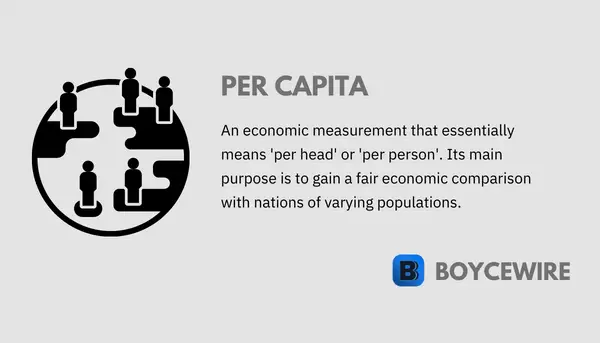Per Capita: Definition, How to Calculate & Examples

What is Per Capita
Per capita originates from the Latin language – meaning ‘by head’, or ‘per person’. In economics it is used primarily with GDP to find measurements such as GDP per capita, real GDP per capita, GDP (PPP) per capita, and Gross National Income (GNI).
Its primary use is to help compare nations with different population sizes. This helps us gauge how ‘rich’, or economically effective two nations are. For instance, the GDP of India and the UK is $2.8 trillion. Yet the population of India is 1.4 billion, whilst the UK is home to only 67 million.
This vast difference in population shows that in per capita terms, the economic gap between the UK and India is miles apart – even though nominal GDP is the same. For example, GDP per capita in Indian is $2,000 compared to $43,000 in the UK.
By using per capita as a measurement, we get a more accurate comparison of economic output between countries. Furthermore, it also provides a better understanding of true economic growth. For instance, an economy may grow at 3 percent in one year, with its population growing by 1.5 percent. Whilst the economy grew, 1.5 percent of the growth could be attributable to population growth. Economic output will inevitably increase with more people, but doesn’t mean that there have been productivity gains.
Key Points
- Per capita is a measurement that helps compare different nations statistics on a ‘per person’ basis.
- Per capita helps economists compare GDP figures by accounting for large differences in population.
- By using per capita, economists are able to more accurately compare the size of two nations economies.
How to Calculate Per Capita
Per capita calculates the measurement of a country on a per-person basis. That may be GDP or income. Whatever the statistical measure, it can be calculated using the formula:
Per Capita Formula

This provides a more comparable measurement as it allows for more accurate analysis between nations. It is not only used for economic statistics such as GDP but can be used in other social sciences. For example, you can use per capita to calculate the number of car accidents. You could do this using the following calculation:

If we go back to economics – per capita is generally used to measure GDP. This allows us to compare countries whereby the size of their population varies dramatically. Let us now take an example:
Example of Per Capita
In 2019, the US population was 328 million, whilst its economic output was valued at $21.43 trillion. To calculate GDP per capita, we get the total GDP and divide by the total population. In this case it is:

So in 2019, the GDP per capita of the US was $65,335. If we now compare that to India, where the population was around 1.36 trillion, with a GDP of $2.72 trillion. We divide the total GDP by the population:

In 2019, the GDP per capita for India was $2,000 – significantly less than that of the US.
Advantages of Per Capita

1. Positive Correlation with Key Indicators
When countries such as China have a high GDP figure, yet have a high proportion of its population in poverty – it can be argued that GDP means little. By calculating GDP on a per capita basis, it allows us to get a more accurate picture of the economic output of each individual. After such, the GDP of China is not actually that high by comparison.
On a per capita basis, GDP is a much more effective indicator of quality of life. For instance, there are a number of studies that show correlation with factors such as life expectancy, happiness, crime, and the income of the poor. We can conclude that on average, higher levels of GDP per capita can be associated with some key quality of life statistics.
2. Compare Countries
By using per capita, we are able to identify the average income within a country. This can be useful for businesses that are making investment decisions as it allows them to identify an investment plan. For instance, low-income countries cannot afford Ferrari’s and Lamborghini’s. Instead, it may be useful to target budget goods that are affordable.
Countries such as India and China have a high GDP, but it is misleading due to the size of their populations. Both are still relatively poor nations despite having GDP in excess of countries such as the UK and France. By using per capita, it presents a more accurate picture of where they are at in their economic development.
Countries that are still developing may make strong gains in GDP per capita. This may send a signal to foreign and domestic businesses that it is a good time to invest in the country. During the initial development phase, they may be able to establish themselves as a big name in the market and secure a dominant position.
3. Helps Businesses with Decision Making
Per capita helps businesses identify income levels in different parts of the country whilst making a like for like comparison. For instance, the GDP per capita in California was over $70,000 in 2019, whilst it was just over $41,000 in Alabama. The difference is quite striking, but it allows businesses to make decisions that suit them. For instance, a manufacturing business that relies on low-skilled, cheap labour, may look to invest in Alabama. By contrast, a luxury watch brand may look to operate and sell its good in California where incomes are higher.
4. Widely Available Statistics
One of the biggest advantages of using GDP per capita and per capita, in general, is that population figures are widely available in each nation. This is because each nation keeps some form of records of births and deaths in the country – as well as conducting census’. Whilst it could be said that some countries such as Sudan and the Central African Republic are unreliable, the statistics that are available still give a good indication of size.
Other measures such as Purchasing Power Parity (PPP) and inflation are much less reliable as they require data that is not so commonly available and rely on survey results. At the same time, there are many statistics, including PPP, that are not widely available as a result. Even when results are available, they are at irregular intervals.
Limitations of Per Capita
1. Age Differences
One of the issues of calculating GDP per capita is that it calculates the economic output of the whole population. However, there are economies such as India, where the population is heavily skewed to the youth. For example, the median age in India is 28, yet in the US, it is over 38 – that’s an extra 10 years.
Such large differences in age means there are many young people who are in education and therefore not producing an economic output. GDP per capita doesn’t consider this, so is likely to devalue the true economic output per person for countries with a large youth population. Instead, a more accurate measure would be through ‘per worker’. That way, any differences in age can be accounted for as it only accounts for those who are actually working and producing an economic output.
2. Distribution of Income
GDP per capita and income per capita both look at the average statistics. This can lead to misleading outcomes where there are significant statistical outliers. For instance, India, Ghana, and Nigeria, all have a relatively similar GDP per capita at around $2,000. Yet all three countries have different levels of absolute poverty.
According to the latest World Bank data, over 50 percent of the Nigerian population live in absolute poverty – that’s less than $1.90 a day. Yet despite having similar levels of GDP per capita, India and Ghana have 21 and 13 percent of their respective populations in absolute poverty. The reason for such vast contrasts is the extreme disparities in the distribution of wealth and income. Those who are at the top are extremely rich, whilst those at the bottom are extremely poor.
3. Doesn’t consider the cost of living
Per capita statistics show comparable levels of GDP and income, but it does not factor in the cost of living. For example, income per capita in India is around $2,000, yet $1 in India can buy many more goods and services than in the US. If we take the classic Big Mac as an example – it costs $2.50 in India, but $5.70 in the US. So in India, you can buy two Big Macs and still have change left over.
We also have other important costs such as food, rent, and electricity – all of which are significantly cheaper, thereby allowing $1 to stretch further than in the US. So when we consider income per capita, we are looking at what $1 would buy in the US, rather than India. Even though the GDP per capita of India is $2,000 – that can buy the equivalent of roughly $7,000 worth of goods in the US. That is if we measure using GDP per capita with the addition of PPP, which adjusts for local purchasing power.
Related Topics
FAQs
GDP per capita means GDP per person. In other words, what the GDP is per person. It can be calculated by dividing GDP by the population of the nation. For example, the US GDP is $21.43 trillion, and its population is 328 million. We would divide the GDP by the population which would equal $65,335.
We can calculate using per capita using the formula – measurement per capita = measurement / population. For example GDP per capita = GDP / population.
Per capita essentially means ‘per person’. It is a measurement that allows us to be able to compare statistics in different nations with different population sizes.
About Paul
Paul Boyce is an economics editor with over 10 years experience in the industry. Currently working as a consultant within the financial services sector, Paul is the CEO and chief editor of BoyceWire. He has written publications for FEE, the Mises Institute, and many others.

Further Reading
 Coefficient of Determination - The coefficient of determination is a statistical measure that indicates the proportion of the variance in a dependent variable that…
Coefficient of Determination - The coefficient of determination is a statistical measure that indicates the proportion of the variance in a dependent variable that…  Commodity Money: What it is, Why it has value & Examples - We can define Commodity money as a physical good that consumers universally use to trade for other goods. In other…
Commodity Money: What it is, Why it has value & Examples - We can define Commodity money as a physical good that consumers universally use to trade for other goods. In other…  Demographics - Demographics refers to the statistical characteristics and trends of human populations, providing insights into factors such as age, gender, race,…
Demographics - Demographics refers to the statistical characteristics and trends of human populations, providing insights into factors such as age, gender, race,… 